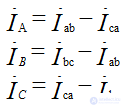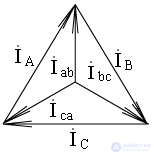The currents in the phases are determined by Ohm’s law:

or

Line currents are determined by phase currents according to the first Kirchhoff law:

The line currents are equal to the vector difference of the phase currents of the phases that are connected to this line wire.

Regardless of the nature of the load, the sum of linear currents is always 0.
When one of the phases changes, the operation mode of the other phases remains unchanged, since generator linear voltage remains constant. The delta connection is used for asymmetric loading.
Vector current chart:






Comments
To leave a comment
Electrical Engineering, Circuit design
Terms: Electrical Engineering, Circuit design